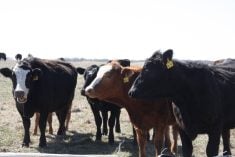This cattle market information is selected from the weekly report from Canfax, a division of the Canadian Cattlemen’s Association. More market information, analysis and statistics are available by becoming a Canfax subscriber by calling 403-275-5110 or at www.canfax.ca.
Fed market steady
The overall market tone was steady to softer last week as feedlots worked hard to slow seasonal easing in the fed market. Alberta rail steer prices traded steady to $5 per hundredweight lower than the previous week, ranging from $388.50-$393.50/cwt. f.o.b. the lot ($234.80 per cwt. live).
Read Also

Why feds imposed EV tariffs
Moe and Kinew have a fight on their hands when it comes to eliminating the EV tariff. Canada has to worry about pissing off the U.S. and Mexico and hundreds of thousands of auto workers.
Average rail steer prices were $2 per cwt. lower than the previous week. Last year, fed steer prices were in the middle of their price climb, though prices were largely steady through August. Heifer trade was too slight to establish a weekly trend.
Two weeks ago, Canadian fed slaughter was 52,146 head, the second largest weekly fed volume since the end of March. Weekly western fed slaughter was 42,587 head, steady with the previous week. Western fed slaughter volumes remain seven percent below last year and are only two percent higher than the five-year average. The Alberta cash-to-futures basis was -$3.26 per cwt.
In Ontario, fed steer prices were $3-$9 per cwt. lower than the previous week, at $387.50 per cwt. dressed ($232.50/cwt. live), averaging $5 per cwt. lower. Weekly eastern slaughter volumes are near the low end of the range, at 9,559 head.
The five-year average shows that Alberta fed steer prices typically move mostly sideways right through to the end of September, before rallying to end of the year.
In the United States, trade again moved at a snail’s pace. Colorado reported trade at $188 per cwt. In Iowa, 1,500 head traded at $180-$190.50 per cwt. live ($297 per cwt. dressed). In Nebraska, 6,500 head traded at $188 per cwt. ($295 per cwt dressed).
For the week ending July 21, total slaughter was 625,915 head, 5.7 percent lower than the same week last year and 3.9 percent lower than the five-year average. Beef cow slaughter was 65,704 head. Year-to-date fed slaughter is 3.3 percent lower than last year. Year-to-date heifer slaughter dipped 1.1 percent below year ago levels, but is 6.5 percent higher than the five-year average.
Lower cow volume
Western Canadian packer interest has moderated and feeder cow buyers continue to be active on the non-fed market. There has been a noticeable decline in cow volumes through commercial auction facilities over the past couple of weeks.
Butcher bull volumes increased sharply. Some auctions reported 50-70 slaughter bulls at weekly sales.
Cow prices usually see a bit of a rally in early August, but not this year. Cow prices were $2 per cwt. lower last week and have dropped $5 per cwt. over the past three weeks. There have been a few grain-fed cows hitting the market, and premiums of roughly $5-$10 per cwt. were seen, compared to cows coming off grass. D2s averaged $149.94 and D3s averaged $134.38 per cwt.
Over the previous four weeks, western Canadian cow slaughter totalled more than 25,000 head. For July, this is the largest slaughter volume since 2009. Cow slaughter volumes usually bottom in August and increase through to November. In drier areas of the province, there have been reports community pastures will be sending cows home earlier than normal.
Alta. feeders at premium
For the first half of this year, Ontario steers heavier than 900 lb. on average were at a $12 per cwt. premium compared to the Alberta market, but Alberta 900 lb. and heavier feeder prices recently moved to a premium against the Ontario market.
Closing over US$1 per cwt. higher on Aug. 4, the August 2024 live cattle contracts set new highs. With western Canadian feedlots booking a lot of U.S. corn for fall delivery and into the new year, note that since late July, the December corn contract has dropped over 70 cents per bushel.
Last week, British Columbia, Alberta and Saskatchewan five-weight steer calves for October/November delivery traded from $362-$434 per cwt. with a weighted average price of $389.80 per cwt. based at 540 lb.
For the first three weeks in July, Canadian feeder cattle exports to the U.S. have totalled just over 10,000 head, the largest for that period since 2015. Dry conditions continue to be noted in B.C., and larger auction volumes are running well above last year.
Cutouts near steady
In U.S. beef trade, Choice cutouts bounced just north of the US$300 per cwt. mark again and closed steady with last week at $302.01 per cwt. Select cutouts were off slightly to $278.31 per cwt.














